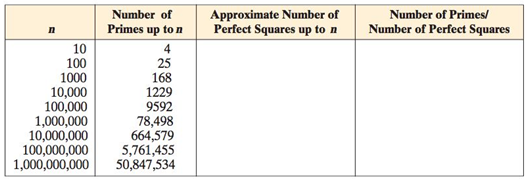
Concept explainers
Perfect squares versus primes. Using a calculator or a computer, fill in the last two columns of the following chart.

Given the information found in your chart, what do you conclude about the proportion of prime numbers to perfect squares? Are prime numbers more or less common than perfect squares? Using the Prime Number Theorem, estimate the quotient of the number of primes up to n divided by the number of perfect squares up to n. Use a computer or a graphing calculator to graph your answer. Does the graph confirm your original conjecture?
Want to see the full answer?
Check out a sample textbook solution
Chapter 2 Solutions
HEART OF MATHEMATICS
Additional Math Textbook Solutions
Thinking Mathematically (6th Edition)
Algebra and Trigonometry (6th Edition)
Probability And Statistical Inference (10th Edition)
Intro Stats, Books a la Carte Edition (5th Edition)
Using and Understanding Mathematics: A Quantitative Reasoning Approach (6th Edition)
- Pet Owners According to the Humane Society, in 2015, 65% of U.S. households owned at least one pet, and 42% of households who did own pets owned at least two. The U.S. Census Bureau tells us that there were 117 million households in 2015. How many households owned at least two pets? Report your answer in millions rounded to two places.arrow_forwardIn horse racing, a “trifecta” occurs when a bettor wins by selecting the first three finishers in the exact order (1 St place, 2nd place, and 3rd place). How many different trifectas are possible if there are 14 horses in a race?arrow_forwardSeating Capacity Determine the seating capacity of an auditorium with 36 rows of seats when there are 15 seats in the first row, 18 seats in the second row, 21 seats in the third row, and so on.arrow_forward
- Committee Members A U.S. Senate Committee has 14 members. Assuming party affiliation is not a factor in selection, how many different committees are possible from the 100 U.S. senators?arrow_forwardBaling Hay In the first two trips baling hay around a large field, a farmer obtains 123 bales and 112 bales, respectively. Each round gets shorter, so the farmer estimates that the same pattern will continue. Estimate the total number of bales made after the farmer takes another six trips around the field.arrow_forward

 Functions and Change: A Modeling Approach to Coll...AlgebraISBN:9781337111348Author:Bruce Crauder, Benny Evans, Alan NoellPublisher:Cengage Learning
Functions and Change: A Modeling Approach to Coll...AlgebraISBN:9781337111348Author:Bruce Crauder, Benny Evans, Alan NoellPublisher:Cengage Learning Holt Mcdougal Larson Pre-algebra: Student Edition...AlgebraISBN:9780547587776Author:HOLT MCDOUGALPublisher:HOLT MCDOUGAL
Holt Mcdougal Larson Pre-algebra: Student Edition...AlgebraISBN:9780547587776Author:HOLT MCDOUGALPublisher:HOLT MCDOUGAL Glencoe Algebra 1, Student Edition, 9780079039897...AlgebraISBN:9780079039897Author:CarterPublisher:McGraw Hill
Glencoe Algebra 1, Student Edition, 9780079039897...AlgebraISBN:9780079039897Author:CarterPublisher:McGraw Hill Algebra: Structure And Method, Book 1AlgebraISBN:9780395977224Author:Richard G. Brown, Mary P. Dolciani, Robert H. Sorgenfrey, William L. ColePublisher:McDougal Littell
Algebra: Structure And Method, Book 1AlgebraISBN:9780395977224Author:Richard G. Brown, Mary P. Dolciani, Robert H. Sorgenfrey, William L. ColePublisher:McDougal Littell College Algebra (MindTap Course List)AlgebraISBN:9781305652231Author:R. David Gustafson, Jeff HughesPublisher:Cengage Learning
College Algebra (MindTap Course List)AlgebraISBN:9781305652231Author:R. David Gustafson, Jeff HughesPublisher:Cengage Learning





